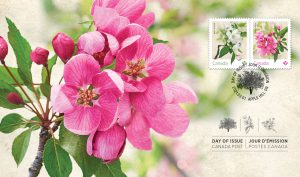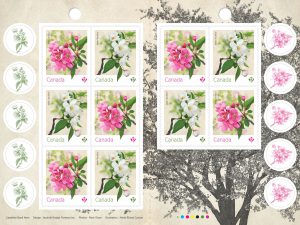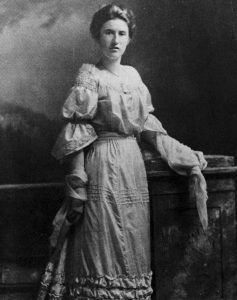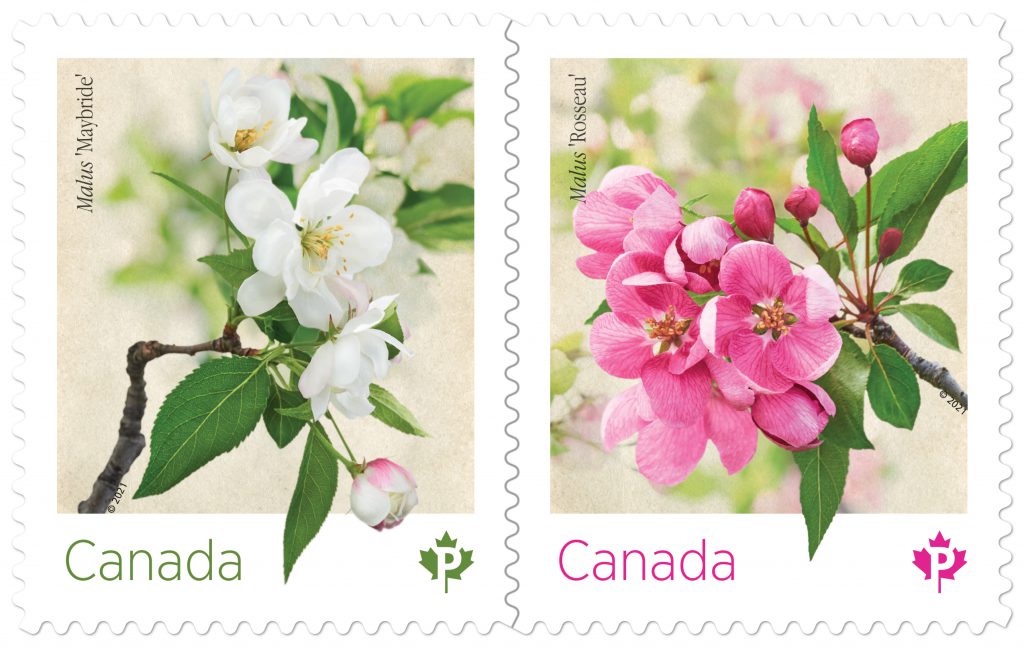By Jesse Robitaille
Today, less than three weeks before the start of spring, Canada Post issued its latest set of flower stamps.
The Crown corporation’s 18th botanical springtime issue since 2004, this year’s two-stamp set features a pair of Canadian-bred crabapple blossom varieties.
One of the stamps features the pretty pink flower of the Rosseau crabapple, introduced in 1928 at Ottawa’s Central Experimental Farm by a pioneering ornamental plant breeder, Isabella Preston, who died in 1965.
Canada Post also featured a lilac variety developed by Preston on one of the two stamps (Scott #2208) issued as part of the 2007 “Flowers” series.
The second stamp depicts the delicate white bloom of the Maybride crabapple, a dwarf cultivar bred by Preston’s successors, Daniel Foster Cameron and Dexter Reid Sampson.
Crabapple species, only about nine of which are native to North America, often grow in the shade of other trees and along fences and roadsides, according to Tree Canada, the only national non-profit organization dedicated to planting and nurturing trees in rural and urban environments. In Canada, crabapple trees are often found near Lake Erie and Lake Ontario in southern Ontario.
While the trees’ fragrant blossoms are a welcome sign of spring, their small, slightly sour fruit is commonly used for homemade jams and jellies. Crabapple wood, meanwhile, is used for smoking meats and cheeses with a “pleasant, fruity aroma,” according to Mike Kay, a board member with the Frederick County Forestry Board, writing for the Frederick News-Post in 2016.

The set’s official first-day cover features both stamps tied by a single cancel from Apple Hill, Ont.
STAMP DESIGN
The crabapple blossom stamps were designed by Toronto’s Sputnik Design Partners with illustrations by Marie-Élaine Cusson, of Pointe-Claire, Qué., and photography by Mark Olson, of Etobicoke, Ont.
Cusson also designed Canada Post’s 2016 hydrangea stamps (SC #2896-2900).
The 10-stamp booklets, two-stamp souvenir sheets and two-stamp official first-day covers (OFDC) were printed by the Canadian Bank Note Company while and the 50-stamp coils were printed by Lowe-Martin (all using six-colour lithography, PVA gum and Tullis Russell paper).
A total of 600,000 booklets, 70,000 souvenir sheets, 130,000 coils and 7,000 OFDCs were printed. The booklet stamps measure 26 millimetres by 32 millimetres, the souvenir sheets measure 120 millimetres by 84 millimetres, the coil stamps measure 20 millimetres by 24 millimetres and OFDCs measure190 millimetres by 112 millimetres.
Each OFDC is serviced with a cancel from Apple Hill, Ont., a community in North Glengarry named in 1882 after being “built through Sandy Kennedy’s apple orchard,” according to the Dictionary of Canadian Place Names.
The yearly flower stamp tradition – typically issued just before wedding season – stretches back to 2004, with the beginning of a seven-year “Flowers” series.

The 2021 flower stamps are available in 10-stamp booklets with labels (shown), two-stamp souvenir sheets and 50-stamp coils.
After that, each year’s issue focused on a specific flower, including:
- sunflowers (2011);
- daylilies (2012);
- magnolias (2013);
- roses (2014);
- pansies (2015);
- hydrangeas (2016);
- daisies (2017);
- lotuses (2018);
- gardenias (2019); and
- dahlias (2020).

Isabella Preston, a prominent ornamental plant breeder working at Ottawa’s Central Experimental Farm, introduced the Rosseau crabapple tree in 1928.
CRABAPPLE HISTORY
While the crabapple blossoms’ fragrant smell serves as a reminder of spring’s arrival, the tree has a spotted history, according to a story published by the Ottawa Citizen in 2017.
“Ottawa was almost the crabapple capital but it turned out to be a messy business,” reads the story printed as part of a “Canada 150” series.
A crabapple tree cultivar known as the “Almey” was chosen in 1967 to be Canada’s centennial tree. Planted across the country beginning in 1966, the variety found deep roots in Ottawa, where the local government gave residents 18,000 saplings while the federal government planted thousands more, the Citizen story adds. Because of popular demand, a second cultivar known as the “Royalty” was added to the plantings as Ottawa aimed for world fame through its crabapple blossoms.
Unfortunately, those trees were prone to disease, and “the abundant red crab apples became a messy nuisance underfoot on city sidewalks,” environmental historian Joanna Dean, an associate professor at Carleton University, writes in her 2014 book, Urban Forests, Trees, and Greenspace: A Political Ecology Perspective.
“By the time the trees had reached their full commemorative glory, opinion had shifted.”
The Citizen story adds the Central Experimental Farm curator eventually “warned people to ‘steer clear’ of a half-dozen different crabapples – including the two centennial picks.”
2021 STAMP PROGRAM
After the “Crabapple Blossoms” set – the only stamp issue in March – the 2021 stamp program will continue in April with:
- a so-called “award-winning” stamp on April 8;
- an issue marking the 100th anniversary of insulin’s discovery on April 15; and
- an Eid stamp on April 22.

